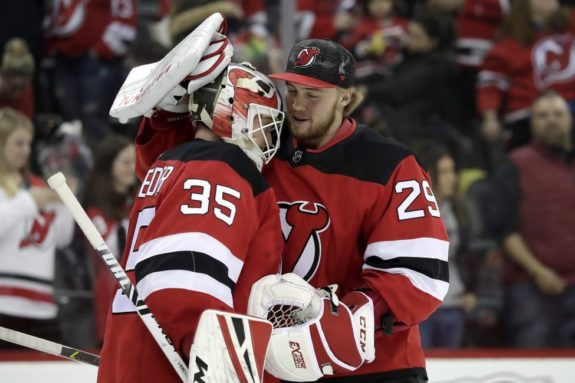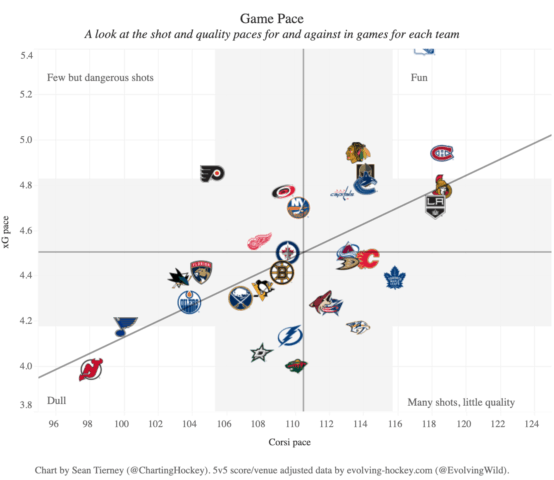The New Jersey Devils could not have gotten off to a worse start to the 2019-20 season. They had a 0-4-2 record across their first six games and lost them in some unimaginable ways. They blew multiple multi-goal leads, including a four-goal lead against the Winnipeg Jets on opening night. It’s not like the Devils were the victims of bad luck, either, as their play warranted the losses.
But since their difficult start, things are starting to coming around. They’re 4-1-2 over their last seven games, and their play has seen some noticeable improvement. There’s a long way to go before they return to playoff contention. But if they keep playing the way they are, they can put themselves back in the conversation.
Analyzing the Devils’ Poor Start
Teams don’t usually start 0-4-2 by accident, and there are plenty of reasons why the Devils got off to such a bad start. But before getting started, it’s worth noting the NHL had a problem with its shot location data, which affected stats like expected goals (xG) through Oct. 15. Even though the numbers may be a bit off (it’s unknown to what extent), they still give us a barometer of how the Devils were playing through their first six games. So let’s get into the reasons behind their bad start.
First and foremost is their goaltending, which was a big question mark heading into the season as is. Through their first six games, they had a save percentage (SV%) of .856, ranked second to last in the NHL to the Los Angeles Kings. The league average is around .908%, so it’s tough to win many games when your goaltending is that far below the league average.

While poor goaltending will always bring a team down, the Devils’ play in front of their netminders didn’t help, either, as their five-on-five shot rates were among the league’s worst. They had a Corsi for (CF%) of 45.88%, ranked fifth-worst in the NHL through their first six games. And their expected goals for percentage (xGF%) wasn’t much better, as it ranked sixth-worst.
A big reason for that was the Devils’ inability to defend. They were still looking for the right defense pairs after acquiring P.K. Subban in a trade at the Entry Draft, so there was plenty of mixing and matching among their blueliners. They also struggled mightily with defensive and neutral zone turnovers. Combine that with trying to find the right combos, and it’s a snowball effect that led to some significant defensive struggles.
Related: Devils Need to Embrace High-Energy Hockey
The same is true for the Devils’ up front, at least when trying to find the right set of lines. They signed Wayne Simmonds as a free agent, acquired Nikita Gusev in a trade, and drafted Jack Hughes with the first overall pick at the Entry Draft. It didn’t affect the team’s ability to generate offense, as they had the 15th best xG for (xGF) through their first six games. But there wasn’t much chemistry among their lines. And Hughes was having a tough time adjusting to life in the NHL in his first few games, which also didn’t help matters.
What Have They Changed?
Well, for starters, the NHL fixed its shot location issue, so stats like xG are reliable from Oct. 16 onward, when the Devils’ 4-1-2 stretch began. Since then, they’ve seen a noticeable improvement in their five-on-five shot rates. They have a CF% of 48.94% and xGF% of 55.32%, the latter of which ranks fourth-best in the NHL.
A big reason for their improved xG share comes from their defense, as they have an xG against (xGA) of 9.05. The next best number is the Minnesota Wild’s xGA of 11.77, which is a good ways away from the Devils’ league-leading rate. The Devils’ style of play seems to be helping matters, too. They’re playing at the slowest pace of any NHL team. So the number of shots and chances for either team in a Devils’ game will be limited, which is why they have the lowest xGF in the NHL over the last seven games.

While the Devils’ style of play is making a difference, they seemed to have found a steady top-four among their blueliners. Subban and Damon Severson have found chemistry as the top pair — the team has a 57.06 CF% and 67.16% xGF% with them on the ice since Oct. 16. The team’s second pair of Andy Greene and Sami Vatanen seems to be clicking, as well — they have an xGF% of 62.99%.
Things are also coming into focus among their forwards. After a rough start, Hughes has seen plenty of minutes on the first line alongside Taylor Hall and Kyle Palmieri. He’s thrived in that role, and the line has a 64.58% xGF% since Oct. 16. That’s allowed Nico Hischier to carry the second line with Pavel Zacha as a left-winger and either Jesper Bratt or Nikita Gusev as right-wingers, except for last night’s game against the Jets which saw Hischier and Hughes flip spots.
Related: Devils’ Goaltending Needs to Be Better
Despite going 4-1-2 over their last seven games, the Devils’ SV% is still in the bottom 10 of the league. Cory Schneider is a shell of what he used to be and has an SV% below .850 through five starts. General manager Ray Shero addressed this by acquiring Louis Domingue from the Tampa Bay Lightning, but he’ll serve as the team’s third option in net. That leaves Mackenzie Blackwood to pick up the slack, and he’s been able to do so. He has a .919 SV% over his last six starts. So if he continues playing at that level, the Devils should be able to keep winning consistently.
Devils Learning to Close out Games
The last area of concern the Devils needed to address was their ability to close out games. Poor goaltending plays a role in that, but some shaky play in the neutral and defensive zones didn’t help, either. They had quite a few leads during their 0-4-2 stretch but blew almost all of them because of those reasons.

The Devils have cleaned that up quite a bit during this recent run of theirs. It hasn’t been perfect, but the glaring turnovers have been cut down, and that’s made life a lot easier for them late in games. This was especially true in a 5-3 win over the Carolina Hurricanes Saturday night, and in their shootout win against the Jets last night.
It also helps that Blackwood has elevated his game, especially with Schneider’s struggles. It’s his job to lose, at this point, and he’ll keep it if he maintains anything above a .910 SV%. That, along with the Devils’ improved five-on-five play, and they can get back to relevancy. It may take some time, but that’s something they’ll live with after a horrendous start to the season.
* * *
Advanced stats from Natural Stat Trick